Consumer and personal health data will play a larger role in clinical research in the future.
More and more data relevant to health are being captured by consumers and patients through patient diaries, monitoring devices, and health and fitness tracking diaries, and apps. Patient and consumer data, experts say, can provide better measures of everyday behavior. Researchers and others in healthcare are beginning to look at whether everyday behavior and lifestyle information can fill the gaps in knowledge for better healthcare decision making.
This push for how data can be best harnessed for clinical insights will be driven by patients. Doctors, health plans, and pharmaceutical company sponsors will have to respond to this push by patients for a more connected health experience.
A 2013 survey by Pew Research Center’s Internet & American Life Project found that 69% of U.S. adults keep track of at least one health indicator such as weight, diet, exercise routine, or symptoms. People living with one or more chronic conditions are significantly more likely to track health indicators or symptoms and this likelihood increases among those living with more than one condition.
Pharma industry experts say this explosion of data presents a unique opportunity for clinical research. There is an opportunity for using data science and software to improve the clinical development process.
While glucose numbers, other types of monitored health indicators, and patient-reported outcomes have been used in clinical trials for some time, the introduction of fitness and health apps and other new digital tools allows for more accurate and precise data to assess patient behavior that goes beyond patient diaries.
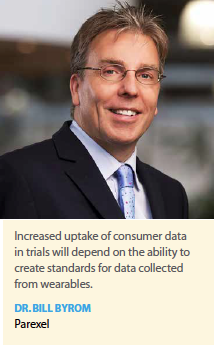 Data from wearables will allow greater insights into the safety and efficacy of treatments, says Bill Byrom, Ph.D., senior director, patient direct, at Parexel Informatics.
Data from wearables will allow greater insights into the safety and efficacy of treatments, says Bill Byrom, Ph.D., senior director, patient direct, at Parexel Informatics.
“The richness of the data is huge, and having the ability to understand small changes in a patient’s mobility, for example, can have a huge impact," he says. “In a COPD patient, for example, becoming more mobile will have a big impact on a patient’s quality of life and that is an important outcome of the treatment. A clinic fitness test can’t really get to the endpoint, but an at-home intensive understanding of activity level and mobility becomes a rich source of data that helps us to understand the impact of treatment on patients."
The uptake of wearables and medical fitness apps is analogous to where the dot.com trend was in the late 1990s, says Dan Brunetti, VP of account management and operations, at C3i, a Telerx company.
“There is a tremendous amount of investor confidence within the mobile health and digital health space," he says. “The lion’s share of interest has been around consumer products, the wellness and fitness apps, but we are starting to see that change now that the FDA has issued some guidance around mobile health application development. From a regulatory perspective, the agency has made progress but there is still a way to go."
The FDA in September 2013 issued a final guidance for mobile medical apps, which indicated the agency will apply the same risk-based approach it uses to assess safety and effectiveness for other medical devices.
At the same time, researchers have begun looking at how data from these apps could be used in research. In mid-2013, The Robert Wood Johnson Foundation (RWJF) funded the Health Data Exploration (HDE) Project to gain further insights into how various stakeholder groups think about personal health data and its use for research. In June 2014, the HDE received a $1.9 million grant from RWJF to create a network of researchers, scientists, companies, and others to catalyze the use of personal health data.
The network brings together companies that collect and store personal health data captured through the use of wearable devices, smartphone apps, and social media with researchers.
“This project is about how to advance our understanding of the use of personal health data for research," says Kevin Patrick, M.D., director of the Health Data Exploration Project. “We will be leveraging the efforts of our steering committee and a broader network of people who are working in this area. The data that we are primarily focusing on is from wearable devices such as FitBit and other apps, as well as anything that can be tracked or captured by this exploding group of technologies. We’re also looking at digital trace data, data from social networks, data from encounters with loyalty cards, etc. These data are changing the way we as researchers can understand the lives of individuals, be they healthy or sick, be they on medication or not. These data raise new issues for researchers, such as how is informed consent handled. Does our traditional way of handling informed consent actually work now because these data are essentially ubiquitous and available from multiple sources?"
Dr. Patrick points out that this is changing the game for anyone who is trying to understand health.
“To understand health, we need to understand what is going on with patients on a 24/7 basis, are they taking medication, are there early warning signs that the medication is creating a problem, what social and behavioral influences might influencing the natural history of a brief illness or a chronic disease," he say.
Dr. Patrick’s group is working on several issues such as informed consent as well as privacy, legal, and social ethical issues related to personal health data. All of these areas need further examination to avoid things such as laws that might have the unintended consequences of prohibiting the use of personal health data in health research.
“For example, in the Terms of Use for most devices that capture personal health data, is it sometimes not clear who owns the data, who the data can be shared with, or whether they can be shared with people the patients want them to be shared with such as the doctor," he says. “There is also a lot of work to try to figure out how these data can be interfaced with electronic medical records so that physicians can see, for instance, whether a diabetic patient started a walking program."
Frances Dare, managing director of Accenture Health, says privacy is a real consideration for technology developers or for organizations that want to include data from a wearable or integrate that data with other things like a patient’s EMR.
“The right security measures need to be in place and companies need to think about HIPAA compliance," she says.
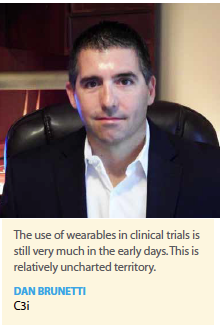 Mr. Brunetti says anytime the Internet is used to transmit data, data privacy comes into question.
Mr. Brunetti says anytime the Internet is used to transmit data, data privacy comes into question.
“Even though a subject may execute an informed consent form at the trial, the data are ultimately going out on the Internet and when that happens, the information is subject to data privacy concerns," he says. “The Health Insurance Portability and Accountability Act (HIPAA) needs to be refined for mobile health technology."
Executives from CSC predict patient-centric R&D will use data from patients’ long-term health histories in a wide range of ways. Standardized, searchable, and comprehensive patient data records — longitudinal clinical data — will provide a wealth of information about specific disease states, predispositions, and therapy effectiveness. These records can identify new sources of candidates for trials and later provide broad evidence-based data about outcomes and cost-effectiveness.
Longitudinal clinical data will also improve safety on many levels, and will support faster adverse event (AE) detection, with better information about population exposure and patient risk.
Consumer Data in Pharma R&D
A recent report by CSC points out that the next generation of R&D is patient-centric. The drive toward personalized medicine and the economic demand for highly effective therapies at a reasonable cost will require companies to create a new paradigm of development, with the patient at the center. An important part of this will be feedback from patients themselves.
New tools are emerging with the ability to mine and find correlations across various data types and across different systems. Informatics will enable the collection and analysis of genomic, safety, and clinical data along with data gleaned from patient reported outcomes, to be combined with electronic health records to be able to gain real insights into the patient experience.
One such assessment tool for gaining insight into patient reported outcomes is an effort by the National Institutes of Health to bring clarity to patient reported data called PROMIS — Patient Reported Outcomes Measurement Information System — which is a system of highly reliable, precise measures of patient-reported health status for physical, mental, and social well-being.
The PROMIS initiative began in 2004 to provide a validated system to measure patient reported outcomes that could be used in clinical research, patient care, and surveys, says James Witter, M.D., Ph.D., program director of the NIAMS rheumatic diseases clinical program at the NIH.
“In essence, this was an effort to transform the measurement of health outcomes in a way that hadn’t existed before," he says.
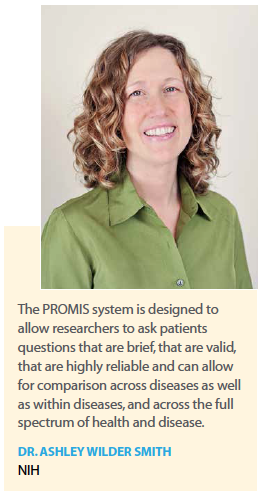 A decade later, the initiative is now in a transition phase, says Ashley Wilder Smith, Ph.D., chief of the NCI Outcomes Research Branch at the NIH.
A decade later, the initiative is now in a transition phase, says Ashley Wilder Smith, Ph.D., chief of the NCI Outcomes Research Branch at the NIH.
“We are now in the dissemination and implementation phase, getting these tools and instruments to researchers," she says.
The PROMIS system is designed to allow researchers to ask patients questions that are brief, that are valid, that are highly reliable, and that can allow for comparison across diseases and within disease, as well as across the full spectrum of health and disease, Dr. Smith says.
“Within PROMIS there is a unique methodology called computer adaptive testing in which individuals’ responses are based on answers to previous questions, thus reducing the number of questions they must answer," she says. “For example, if a patient is asked the question can you walk a block, and the patient says no, we’re not going to ask if that patient can walk three miles. Using this framework, researchers can quickly hone in on the specific ability of the individual or the domain area being measured."
Dr. Witter says when all of the PROMIS instruments are completed and released, there will be more than 100 item “banks" and scales for both adults and children. Currently there are 51 item banks for adults and 18 for children.
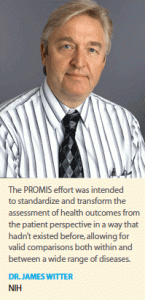 He says another part of this effort includes the establishment of the FDA and NIH Interagency Clinical Outcomes Assessment Working Group, which fosters the development and evaluation and clinical outcomes assessments. Another initiative is the PROMIS Industry Interest Committee, which includes representatives from pharmaceutical, biotechnology, medical device, and diagnostic companies as well as clinical research organizations and consultants who will examine how PROMIS can be applied in industry-sponsored research.
He says another part of this effort includes the establishment of the FDA and NIH Interagency Clinical Outcomes Assessment Working Group, which fosters the development and evaluation and clinical outcomes assessments. Another initiative is the PROMIS Industry Interest Committee, which includes representatives from pharmaceutical, biotechnology, medical device, and diagnostic companies as well as clinical research organizations and consultants who will examine how PROMIS can be applied in industry-sponsored research.
“These interactions are happening at the precompetitive stage so that sponsors have the instruments and outcomes measures to use in all phases of clinical trials — from proof of concept up the chain to Phase III trials," Dr. Witter says. “I’ve heard of sponsors wanting to use this tool as part of the early go/no-go decision process. This approach can really probe into symptoms and quality-of-life issues in a way that a disease-specific questionnaire can’t."
Dr. Witter expects that the FDA will likely issue guidance to encourage companies to use PROMIS measures as exploratory endpoints in their clinical trials.
Another effort is the Patient-Centered Outcomes Research Institute (PCORI), a nonprofit, nongovernmental organization. Congress authorized the establishment of PCORI as part of the Patient Protection and Affordable Care Act of 2010. The group funds comparative clinical effectiveness research (CER), as well as work that will improve the methods used to conduct such studies. PCORI has approved $671 million in funding for 360 patient-centered outcomes research projects since it began funding research in 2012.
Gavin Nichols, VP, IT strategy and R&D at Quintiles, says the ecosystem to understand consumer-generated data and generate meaningful insights is just beginning to develop.
“Without statistical models to look at signals in the data to understand what is being seen, then it’s just noise," he says. “Sponsors need to understand the context of what the patient was doing and have a way to integrate the data with ePRO systems."
mHealth in Pharma R&D
Pharmaceutical companies are beginning to look at how mHealth tools can be used in clinical trials. In November, Pfizer began working with Sanguine Biosciences to use its proprietary mobile application and direct-to-patient platform, called Sangre, to help find and recruit people diagnosed with congenital insensitivity to pain (CIP). This study will be used to help potentially identify DNA mutations and hopefully aid in informing the development of potential therapies for chronic pain.
Also in November, GlaxoSmithKline and Medidata announced they will evaluate the impact of unifying mobile health devices with cloud-based technologies in a clinical trial setting. The joint initiative assesses the capabilities of mHealth tools and evaluates how they can be used to enable a new model for clinical trial conduct.
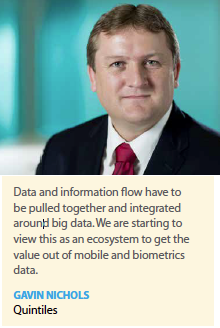 Mr. Nichols says wearables and other mobile technology fit into a bigger area of patient centricity that aims to drive down the burden on the patient and the site, which directly affects time, cost, and quality of information.
Mr. Nichols says wearables and other mobile technology fit into a bigger area of patient centricity that aims to drive down the burden on the patient and the site, which directly affects time, cost, and quality of information.
“For mobile technology to capture biometric information, sponsors need model-based signal detection to interpret the information and an ePRO system that is integrated with an EHR information to capture context," he says. “Sponsors need to be able to conduct centralized risk-based monitoring and have a long-term method of reaching out to patients. We need applications that can help both in the trial setting and in the care setting. The data and information flow have to be pulled together and integrated. We are starting to see an ecosystem develop to derive value out of mobile data and biometrics."
Mr. Nichols says this ecosystem is beginning to come together now through the efforts of early adopters.
“The industry is based on understanding and devising insights from data," he says. “In the same way companies build statistical models to power and show efficacy, they are starting to look at the information feed from FitBit, pedometers, and other consumer data sources. We need to harness technology and incorporate models for statistical analysis so data are qualified and quantified and acted upon in real time instead of at the end of the trial, as we’ve done traditionally."
 For real-time data adoption to increase, more companies, academic institutions, and other parties that are involved in clinical trials will need to convinced that there is real performance value, says Todd Skrinar, principal, advisory services, life sciences, EY.
For real-time data adoption to increase, more companies, academic institutions, and other parties that are involved in clinical trials will need to convinced that there is real performance value, says Todd Skrinar, principal, advisory services, life sciences, EY.
“Early adopters will have to demonstrate to the market that there is value from wearable or other mobile data technology and that the data can be standardized and controlled for collection," he says. “We will see some early adopters that are a little less risk averse to actually prove results."
Wearables and fitness apps are being used in research, but in a fairly limited way as interventions, Mr. Skrinar says.
“Pedometers, for instance, are used in trials as a way to evaluate physical activity to positively impact a condition or as way to incentivize the participants in the trial to hopefully drive more physical activity," he says.
Mr. Skrinar says there are challenges in using wearable pedometers as a source for outcomes data based on activity.
“Using a pedometer as part of an outcomes data set, we are talking monitoring activity outside the hospital or clinic in a less controlled environment and this is where a lot of the challenges begin," he says.
Dr. Byrom says the uptake of fitness and wellness apps has been slow because of a lack of understanding about how to use the devices properly and interpret the data.
“There isn’t a clear guideline or publication, and there are also scientific challenges with interpreting and cleaning the data," he says. “Part of the challenge is because we don’t understand the context in which the data are collected. For example, when looking at activity data and there is a period of inactivity, does this mean the patient was sitting still or does it mean the patient took the device off. This leads to assumptions."
Dr. Byrom says increased uptake will depend on the ability to create standards for data collected from apps and wearables.
“Developing standards around how to use these devices, what the rules are around data cleaning, and interpretation and summary outcomes measures will become important," he says. “Once there is a consensus from key opinion leaders and researchers in the area then pharma companies will feel a little more confident in applying these techniques. There are a lot of questions that need to be answered."
Dr. Byrom says regulatory concerns will likely be around the validity of the data collected through these newer technologies.
“Devices will need to be 510(k) accredited or have some element of validity in terms of their ability to make fairly accurate measurements," he says. “Another regulatory concern will be how the data are interpreted, what assumptions were made, how the data were cleaned, and what endpoints were used to summarize the treatment effect based on the activity. Regulators will want to see some rigor applied to the data to be satisfied."
Mr. Nichols says there has been increased interest in using mobile technology over the last three years with either companion diagnostics or with applications to capture information.
“We’ve integrated data from a FitBit, for example, to look at secondary endpoints," he says. “One sponsor was doing a trial that required patients to take glucose readings every four hours, which is hard for patients especially through the night. The sponsor had trouble recruiting for that trial. The company did a protocol modification that included a wearable glucose monitor for readings through the night, which improved recruitment efforts."
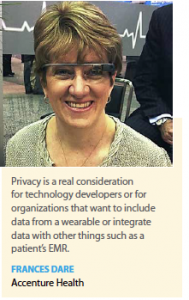 Ms. Dare says one challenge will be overcoming technology fatigue.
Ms. Dare says one challenge will be overcoming technology fatigue.
“People get really excited about new technologies, they may use them for a time, and they may or may not adapt their behaviors in terms of how much they exercise or what they eat," she says. “There is mixed evidence on behavior change. We’re seeing that there is a pretty big drop off after a phase of excitement. People loose interest."
According to a recent Localytics study, 20% of apps are only used once. Still, almost half of Americans are extremely or very interested in being able to check their blood pressure (48%) or their heart and heartbeat for irregularities (47%) on their smartphone or tablet, with an additional 23% and 22%, respectively, saying they’re somewhat interested, according to a recent survey by The Harris Poll.
Another challenge, Mr. Brunetti says, involves interoperability with other systems.
“Sponsors are now extracting data from a number of different devices," he says. “Right now, sponsors are trying to make sense of how they aggregate data and translate the information into business information and ultimately action. Across the value chain, patients benefit from improved outcomes, the pharma industry benefits as patients stay on therapy, and payers benefit because of reduced claims."(PV)
~~~~~~~~~~~~~~~~~~~~~~~~~
Personal Health Data Obstacles
- Privacy and Data Ownership: Among individuals surveyed by the Health Data Exploration Project, the dominant condition (57%) to making their personal health data available for research was an assurance of privacy, and more than 90% of respondents said it was important that the data be anonymous. Further, while some didn’t care who owned the data, a clear majority wanted to own or at least share ownership of the data with the company that collected the information.
- Informed Consent: Current methods of informed consent are challenged by the ways personal health data are being used and reused in research. A variety of new approaches to informed consent are being evaluated and this area is ripe for guidance to assure optimal outcomes for all stakeholders.
- Data Sharing and Access: Among individuals, there is growing interest in, as well as willingness and opportunity to, share personal health data with others. Individuals’ willingness to share is dependent on what data are shared, how the data will be used, who will have access to the data and when, what regulations and legal protections are in place, and the level of compensation or benefit (both personal and public).
- Data Quality: Researchers highlighted concerns about the validity of personal health and lack of standardization of devices. While some of this may be addressed as the consumer health device, apps, and services market matures, reaching the optimal outcome for researchers might benefit from strategic engagement of important stakeholder groups.
Source: Health Data Exploration Project
~~~~~~~~~~~~~~~~~~~~~~~~~
Drug Makers Outsource ?Big Data Initiatives
The number of life-sciences companies maintaining dedicated big data teams is growing. But as pharma companies develop their internal capabilities, many are still looking to specialized vendors and consultants for large-scale studies.
Pharma companies primarily outsource activities in three key stages of big data initiatives: data collection, data storage, and data analysis. In particular, 69% of surveyed pharma companies report outsourcing big data collection. To a lesser degree, pharma companies are also outsourcing data analysis — at 51% of surveyed organizations. Because these initiatives are so data-heavy, specialty vendors may be more equipped to tease out findings than burgeoning internal big data teams.
Source: Cutting Edge Information
~~~~~~~~~~~~~~~~~~~~~~~~~
Thought leader quotes:
 Data and information flow have to be pulled together and integrated around big data. We are starting to view this as an ecosystem to get the value out of mobile and biometrics data.
Data and information flow have to be pulled together and integrated around big data. We are starting to view this as an ecosystem to get the value out of mobile and biometrics data.
Gavin Nichols / Quintiles
 The PROMIS effort was intended to standardize and transform the assessment of health outcomes from the patient perspective in a way that hadn’t existed before, allowing for valid comparisons both within and between a wide range of diseases.
The PROMIS effort was intended to standardize and transform the assessment of health outcomes from the patient perspective in a way that hadn’t existed before, allowing for valid comparisons both within and between a wide range of diseases.
Dr. James Witter / NIH
 The PROMIS system is designed to allow researchers to ask patients questions that are brief, that are valid, that are highly reliable and can allow for comparison across diseases as well as within diseases, and across the full spectrum of health and disease.
The PROMIS system is designed to allow researchers to ask patients questions that are brief, that are valid, that are highly reliable and can allow for comparison across diseases as well as within diseases, and across the full spectrum of health and disease.
Dr. Ashley Wilder Smith / NIH
 The use of wearables in clinical trials is still very much in the early days. This is relatively uncharted territory.
The use of wearables in clinical trials is still very much in the early days. This is relatively uncharted territory.
Dan Brunetti / C3i
 Increased uptake of consumer data in trials will depend on the ability to create standards for data collected from wearables.
Increased uptake of consumer data in trials will depend on the ability to create standards for data collected from wearables.
Dr. Bill Byrom / Parexel
 Technology innovation will help drive the use of consumer data. This is not unlike a lot of new technology introductions in this regard. There will need to be some early adopters that are a little less risk averse to actually prove results.
Technology innovation will help drive the use of consumer data. This is not unlike a lot of new technology introductions in this regard. There will need to be some early adopters that are a little less risk averse to actually prove results.
Todd Skrinar / EY
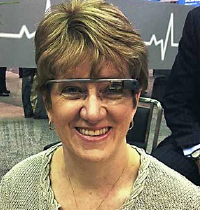 Privacy is a real consideration for technology developers or for organizations that want to include data from a wearable or integrate data with other things such as a patient’s EMR.
Privacy is a real consideration for technology developers or for organizations that want to include data from a wearable or integrate data with other things such as a patient’s EMR.
Frances Dare / Accenture Health


















